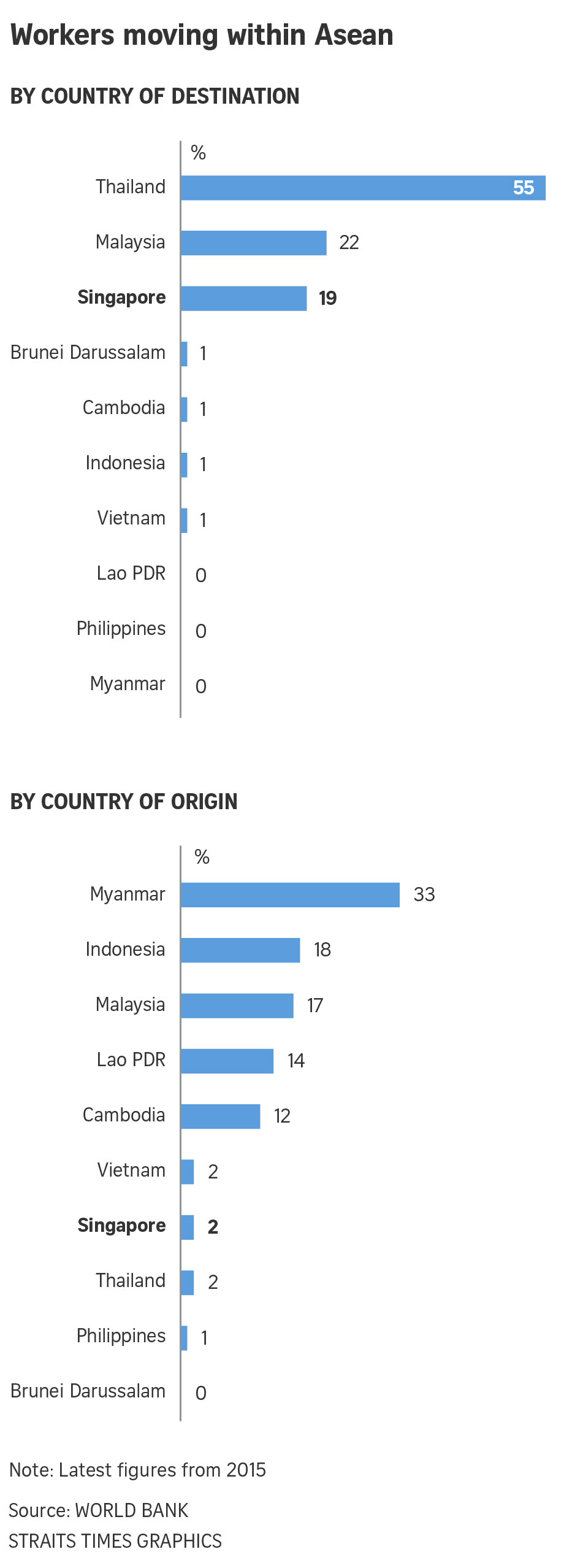SINGAPORE - As Asean seeks to become a more integrated region, it can do more to facilitate movement of people between its member states, said a report by the World Bank.
The report, released on Monday (Oct 9), set out how lower barriers to mobility coupled with a carefully managed migration process in both sending and receiving countries can help workers and economies in the region to enjoy economic benefits.
Steps the World Bank recommended include improving the information workers have about opportunities and their rights, as well as making public more data on skills shortages.
The Asean Economic Community has taken steps to facilitate labour mobility, the report noted, with mutual recognition agreements to standardise qualification recognition in the region.
This means engineers, nurses, architects, doctors, dentists, surveyors, accountants and tourism professionals from one Asean country can work in another provided they meet certain requirements.
But these occupations only account for about 5 per cent of jobs in the region.
In fact, worker welfare - a metric which includes wages and employment - within Asean would be 29 per cent higher if barriers to mobility were reduced for all workers, instead of only 14 per cent if only higher-skilled professions are targeted, the report said.
Three countries - Singapore, Malaysia and Thailand - attract the bulk of migrant workers within the region, most of them lower-skilled but also qualified professionals, the report noted. The three have taken on 6.5 million Asean migrants, 96 per cent of the total.
Asean is also one of two global regions in which the share of migration within the region, out of all migration, rose between 1995 and 2015 - it went up by 10 percentage points.
This is mainly due to continued differences in economic growth and demographic trends among Asean countries, said the report's lead author Mauro Testaverde at a media conference on Monday.
Dr Testaverde is the World Bank's economist for social protection and labour in the East Asia and Pacific region.
Rather than seeing labour movement as a brain drain, the report said the process has resulted in "brain circulation", spreading talent and know-how around the region which is among the fastest growing in a tepid global economy.
High-skilled migrants may acquire education, training and work experience both inside and outside their country of birth, and can facilitate knowledge transfer and trade flows back to their home countries.
World Bank chief economist for the East Asia and Pacific region Sudhir Shetty said: "Labour mobility contributes to continued vitality in the region with benefits not only for migrants themselves but also for sending and receiving countries."
Sending countries receive remittances and expertise from their workers abroad, while in receiving countries migrant workers help to address labour shortages and boost economic growth and competitiveness, he said.
In Singapore, which the report noted has developed a highly sophisticated and well-functioning migration system, the vast majority of migrant workers are low-skilled, and can plug gaps. This allows companies to expand production and employ more local workers, said Dr Testaverde.
However, weaknesses in the region's migration systems persist.
For example, migrant workers do not have perfect information about the opportunities available and the costs, and may be exploited by recruitment agencies and employers charging high fees for job placements.
On the other hand, overly onerous migration processes may result in more undocumented migrants.
The report sets out recommendations to reduce barriers to labour mobility, such as increasing transparency on entry requirements to countries and creating systems for workers to track their progress towards admission to a country.
Singapore's customer rating system for maid agencies, which was rolled out last year to make public maid employers' feedback, was highlighted as an example of a way to increase transparency in the recruitment system for foreign domestic workers.
It can be made more comprehensive by allowing domestic workers to rate the agencies as well, the report noted.
Other recommendations include listing skills shortages using data, which reassures the public that policymakers are closely monitoring the labour market and immigration, as well as instituting pre-departure orientation and financial literacy programmes - which is done in the Philippines - to ensure migrant workers know their rights.



